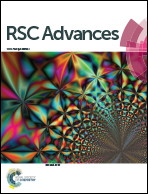Vertically aligned ZnO/ZnTe core/shell heterostructures on an AZO substrate for improved photovoltaic performance†
Abstract
Vertically aligned ZnO/ZnTe core/shell heterostructures on an Al-doped ZnO substrate are developed for non-toxic semiconductor sensitized solar cells. Structural and morphological analysis serves as evidence of the successful synthesis of ZnO nanorods, ZnTe nanocrystals and ZnO/ZnTe heterostructures. The clearly observed quenching of photoluminescence (PL) from the heterostructure indicates efficient charge transfer occurring at the interface of ZnO and ZnTe, due to the type-II energy level alignment constructed by the two. The formation mechanism of the ZnO/ZnTe heterostructure is studied in depth via time-dependent reactions. It was found that the strain between ZnO and ZnTe modifies the band alignment at the interface of the heterostructure in a manner which depends on the growth time. Finally, sensitized solar cells based on the ZnO/ZnTe heterostructures with different ZnTe growth times were fabricated to evaluate the photovoltaic performance. By the careful control of the ZnTe growth time and as a result of the band alignment between ZnO and ZnTe, the power conversion efficiency (PCE) of the vertically aligned ZnO/ZnTe based solar cells could be improved to about 2%, along with a short-circuit photocurrent density of around 7.5 mA cm−2, a record efficiency for ZnO/ZnTe based sensitized solar cells. Notably, for the optimized system the internal quantum efficiency of the ZnO/ZnTe based solar cell approaches 100% in certain wavelengths, implying effective separation of photoexcited free carriers towards either the electrolyte or anode.



 Please wait while we load your content...
Please wait while we load your content...